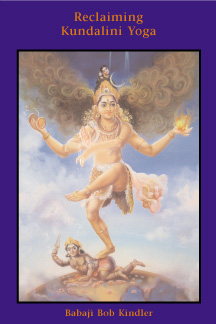
Reclaiming Kundalini Yoga
by Babaji Bob Kindler
ISBN 978-1-891893-11-7
124 pages / $12 USD / click to pre-order
Following the Kundalini Yoga Retreat last October, Babaji was inspired to write a concise and revealing book correcting errors in current thinking and bringing a fresh and authentic perspective to this esoteric subject. All the charts used during the retreat will be included, along with a new translation of the Devi Gita from the Srimad Devi Bhagavatam, and an appendix detailing the role of food in Kundalini Yoga. This book is due out in Spring 2011. A listing of the table of contents and the charts is placed at the bottom of this interview with Babaji.
MM: What specifically has prompted you to write Reclaiming Kundalini Yoga?
Babaji: Kundalini Yoga is considered esoteric and mystical, and is looked askance at by some of those whose Advaitic philosophy recognizes Reality as stationary only. That is, when Reality is immutable and stationary, how can It pass through centers of consciousness called chakras? But how many aspirants, or adepts, even, can realize formless, stationary Consciousness and abide there? Adding to the Kundalini system’s disregard in these times is the fact that during the last fifty years some opportunistic teachers have presented Kundalini Yoga shorn of its deepest spirituality and focused only on hatha yoga and pranayam. But the purpose of Kundalini Yoga is Self-realization. As a result of this dumbing down of Kundalini Yoga philosophy by sensationalists and hatha yogis, people have come to imagine, among other things, that Kunadalini Shakti is actually in the physical spine instead of being taught that the chakras are really found inwardly, in the subtle and causal bodies of humanity – and beyond.
MM: With so many philosophical systems to choose from, why a recall of the Kundalini system at this time in the West’s spiritual growth process?
Babaji: Now, the thing about Kundalini Yoga is that in its authentic form and practice it can appeal to the jnanis (Wisdom seekers) and to the bhaktas (lovers of God). These two are generally at odds with one another, arguing “is God formless or with form?”…as if both cannot be true. The Jnanis are always in the minority, preferring God/Reality without a lot of extras or add-ons, whereas the bhaktas love ritual, chanting, and devotions. Their presence is always more obvious. But Kundalini Yoga runs a middle line. Basically it is about the Kundalini, that dynamic spiritual energy, conceived of as the Mother of the Universe, that rises up (inwards) through the seven chakras. Mother Kundalini is coiled up at the base of the spine, as it were, and Kundalini Yoga is about attracting Mother to uncoil Herself. Thus, if you are a jnani, and you feel Her rising within you, you would feel Her as the flow of Wisdom, as Intelligence — more formless. You would feel Her permeating your thoughts, ideas, and intellect. If you are a bhakta, however, then you would most likely meditate on Her with form, as the Deity which guides via insights and visions, thereby with form — and thus the system is perfect for dhyanis (meditators) as well.
MM: What is the key or hidden message of Kundalini Yoga?
Babaji: What is meant subtly by the Kundalini Yoga system is that the chakra system is really a symbol for what lies within. We are the Atman, and we are everywhere, and we have to wake up to our own internal territories — the realms of Consciousness, the “Kingdom of Heaven within.” We have to become aware of our own Consciousness. Kundalini Shakti is Self Awareness. She’s dynamic and Self-willed, and She is our own Self as well. Kundalini is very much like Atman in Vedanta, or Tathagatagarbha in Buddhism. This is just another way of indicating It — and a very sweetly powerful one at that. <>
Reclaiming Kundalini Yoga
Table of Contents:
Introduction
Chapter One — Straightening the Coil
Chapter Two — Mental Posture and Informed Pranayam
Chapter Three — Nectars and Poisons
Chapter Four — The Kundalini Shakti and Her Chakras
Chapter Five — Tantra’s Shiva and Shakti
Chapter Six — The Devi Gita: Meditation on the Goddess
Chapter Seven — The Devi Gita: A New Translation
Appendix — Further Significance of Food
Sanskrit Glossary
List of Illustrations/Charts
The Role of Food and Prana in Self-Realization
The Twenty Yamas and Niyamas of Tantra
Om and Hrim — The Two Great Bijams
Asana and Pranayam in Tantric Yoga
The Seven Causes and Ten Impediments in Kundalini Yoga
The Seven Centers and Planes of Awareness and Existence
Jnana Chakshu — The Wisdom Eye
Yogic Connections and Correlations in Meditation Practice
The Kundalini Shakti and Her Chakras
Tantra’s Siva and Shakti
Siva’s Two Shaktis, Four Padas, and Five Essential Functions
Meditation on the Goddess
Mother Kali — The Adyashakti
The Four Clarities of Spiritual Life
